Evolution of the concept: from fire ships to unmanned kamikaze boats
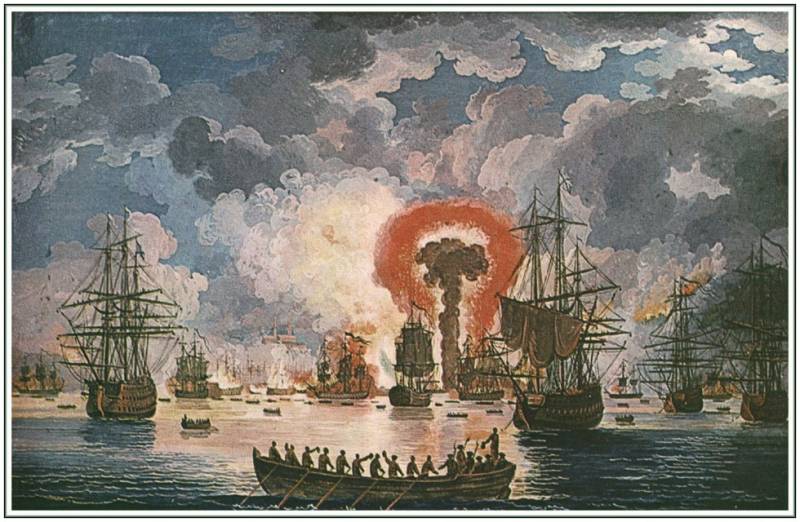
Painting by Ya.F. Hackert "Burning of the Turkish fleet in Chesma Bay" (1771). A mushroom-shaped flash and a cloud in the center - the explosion of Lieutenant Ilyin's fire-ship
In recent months, there has been increased interest abroad in unmanned kamikaze boats. Disposable vessels carrying a warhead of significant mass are intended to be used as a new weapon against surface and coastal targets. Formally, we are talking about a new class of marine equipment, but in fact this is a development of a very old concept of a fire-ship vessel. Such means appeared many centuries ago, but later went out of use for objective reasons.
Distant history
The idea of a special vessel without a crew, capable of approaching enemy ships and setting fire to or blowing them up, is quite simple and was first implemented in the distant past. Subsequently, fireships were regularly used in various naval theaters of war, although with varying degrees of success. As shipbuilding and other technologies developed, the design of kamikaze ships was improved, and the means of protection against them were improved.
At least one of the first cases of using fire ships took place during the Battle of Red Rock on the river. Yangtze in China (208-209 AD). The fleet of Sun Quan, the future ruler of the kingdom of Wu, used against the enemy a large number of boats and vessels loaded with various flammable materials and equipped with hooks. Such fireships successfully reached enemy ships, grappled with them and set them on fire. The fleet of the commander Cao Cao was defeated.
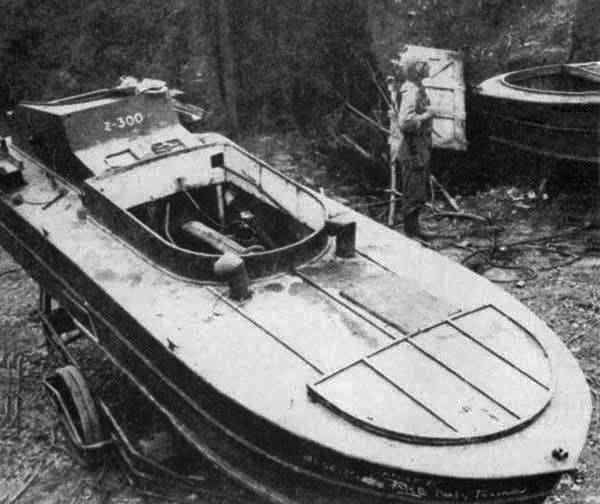
Kamikaze boat "Shinyo" made in Japan. Photo by US Department of Defense
In European navies, fireships began to appear and become widespread in the middle of the last millennium, and they soon showed their capabilities. Thus, it was the ships that were deliberately set on fire that helped the British fleet defeat the Spanish Armada in the Battle of Gravelines (August 8, 1588). It is noteworthy that the fire itself caused minimal damage to the enemy, but due to the threat of the wooden ships catching fire, the Spaniards did not maintain formation and gave the initiative to the British .
Under Peter the Great, fireships also appeared in the developing Russian fleet. They took part in the defense of sea borders and were also used in a number of battles. The feat of Lieutenant D.S. is widely known. Ilyin and his crew in the Battle of Chesma. Their fireship, one of four involved, managed to break through to the Turkish ships and set them on fire - deciding the outcome of the battle. It is curious that most of the Russian fire ships were never used for their intended purpose. They were used in other roles, and were simply dismantled when the resource was exhausted.
Fire ships of this kind appeared in the era of sailing fleets and wooden shipbuilding. In the middle of the XNUMXth century. Metal structures began to become widespread, and the effectiveness of incendiary-equipped ships dropped sharply. The complete transition of warships to metal led to the disappearance of “classic” fire ships.
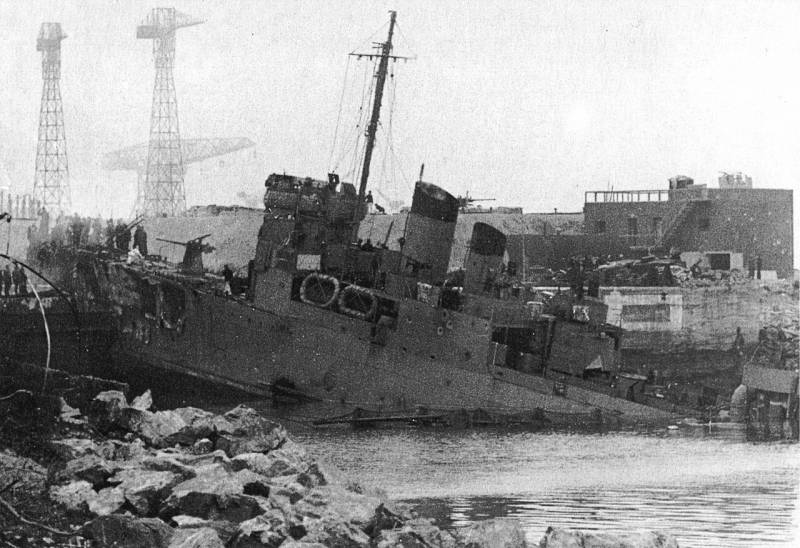
The destroyer HMS Campbeltown at the dock gates in Saint-Nazaire. Soon there will be an explosion. Photo of the Bundesarchiv
Traditional look
A fire ship from the time of wooden shipbuilding was an old or damaged ship or a ship unfit for full service. On deck and/or in holds, incl. with the alteration of the structure, flammable materials and liquids were placed - straw, fascines, turpentine, etc. The simplest explosive devices based on gunpowder could be used. For more efficient ignition, so-called fire starters were laid along the ship’s hull. sausages - long bags of highly flammable material. Ignition devices were installed at the stern; there was also a boat for evacuating the crew. Various hooks, anchors, docks, etc. could be attached to the hull, rigging and spar.
Fire ships could be used both for sabotage in the dark, with minimal probability of detection, and in the midst of battle. It was considered optimal to use it in various narrows and bays that limit enemy maneuver.
The minimum crew had to put the ship on a combat course, fix the sails and rudder, go down into the boat and set fire to the combat load. After this, the ship independently moved towards the target and, with the correct work of the crew and proper luck, ended up in an enemy ship. The hooks helped to grip it for better flame transfer and greater damage from explosions.
New era
Metal ships were practically invulnerable to classic-looking fireships. They began to abandon the latter and look for other ways to hit surface targets. At the same time, the term “fireship” did not disappear - this is how ships that were sunk to limit maneuver or block an enemy fleet began to be called.
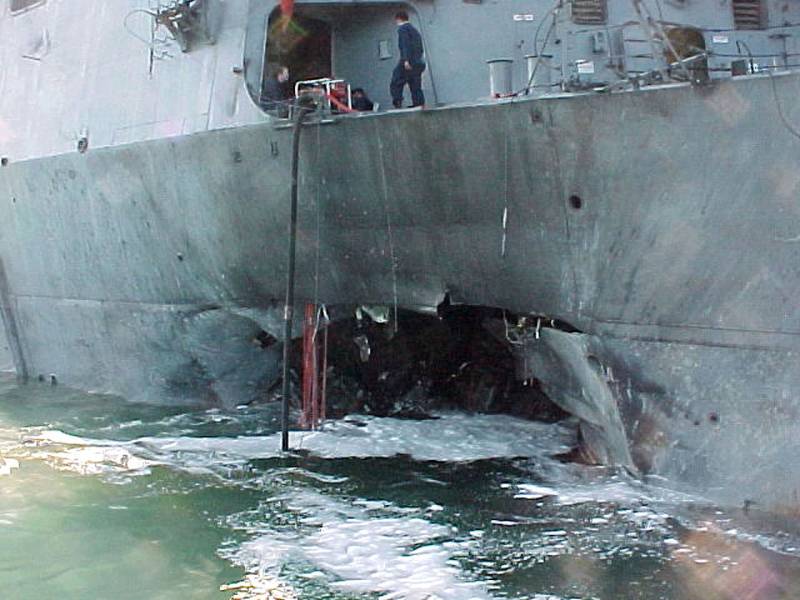
External damage to the destroyer USS Cole, 2000. Photo of the US Department of Defense
However, at the end of the interwar period, kamikaze ships were remembered again. For example, in 1940, exploding MT boats entered service with the 10th MAS Flotilla of the Italian Navy. Wooden boat with a displacement of approx. 1 ton had a gasoline engine and carried 300 kg of explosive with contact and hydrostatic fuses. Under the control of a saboteur-driver, such a boat was supposed to arrive at the target area and set out on a combat course. The driver then sent the boat to the designated object and threw himself overboard. The 10th Flotilla carried out several attacks using MT boats, but saw limited success.
Several MT boats later went to Israel. In 1948, with their help, they successfully attacked an Egyptian patrol ship and a minesweeper. On this story Italian boats ended.
At the end of World War II, the Japanese Navy began using similar Shinyo boats. This vessel had a different design and carried 270 kg of explosives. In addition, there was no provision for evacuation of the driver, and he was driving the boat until the moment of explosion. Several thousand of these boats were built, and dozens were used in battle. At the same time, less than a dozen ships, vessels and submarines were sunk or damaged.
Fire ships, and larger ones, were used by the British Navy. In the fall, he carried out Operation Lucid, a series of attacks on French ports used by the German Navy. Decommissioned tankers filled with a special flammable liquid were used as kamikaze ships. However, due to technical and other reasons, it was not possible to carry out a full-fledged attack.
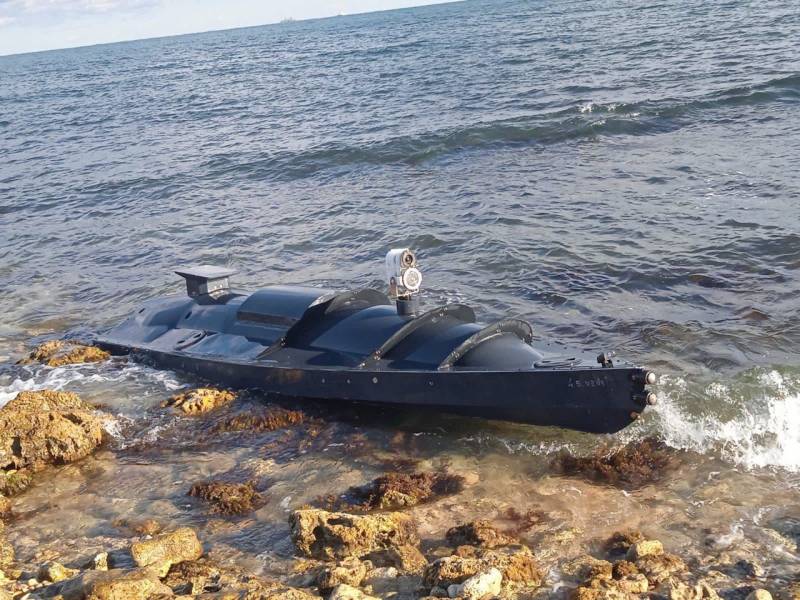
Ukrainian unmanned boat, used in the fall of 2022. Photo Telegram / "Rybar"
Operation Chariot, carried out on March 28, 1942, was more successful. In this case, the fireship was the destroyer HMS Campbeltown, equipped with tons of explosives. The target of the attack was the dry dock of the shipyard in Saint-Nazaire, capable of receiving the battleship Tirpitz. The ship, abandoned by its crew, successfully rammed the dock gate. A few hours later, as planned, it exploded and damaged the plant’s structures, as well as destroyed enemy personnel.
Fire ships of some kind have been used in recent decades. For example, in October 2000, in the port of Aden (Yemen), the American destroyer USS Cole was attacked by a light boat with a crew of two suicide bombers and a charge of about 250-300 kg of TNT. As a result of the explosion, a large hole was formed, units of the power plant were damaged, premises were flooded, etc. Almost 60 people were killed or injured.
Modern solutions
A characteristic feature of the fireships of the past was the need for a person to be present on board in order to advance to the target area and enter the combat course. This imposed known limitations and also reduced the achievable accuracy. The firebrand could not maneuver, and the target had the opportunity to evade. In addition, throughout such an attack, the fireship was a priority target for enemy fire, which, among other things, threatened its crew.
Modern technologies make it possible to get rid of all such problems and create the most effective fire ship. First of all, these are remote control systems. They allow you to control the boat as a whole and its mechanisms until the very moment of hitting the target - without risks for the crew/operator working at a safe distance. In addition, the ship can carry a modern warhead, adapted to solve specific problems.
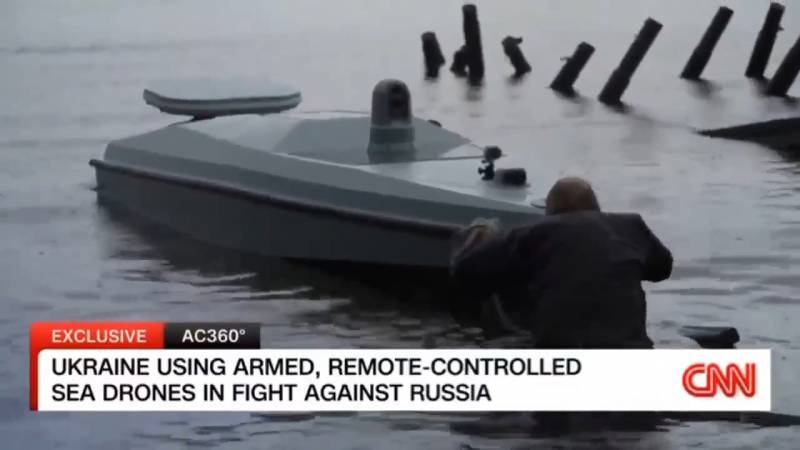
New Ukrainian kamikaze boat. Still from CNN report
Unmanned kamikaze boats are now being developed and used by several foreign countries to increase the strike potential of their fleets. At the same time, some of them use this technique as a replacement for traditional shock systems that are not available for one reason or another.
The potential of unmanned fireboats is now being demonstrated by Ukrainian armed forces. The Kiev regime received several types of such equipment from the UK and is trying to use it against Russian ships and infrastructure. Previously, a successful strike was carried out on the Kerch Bridge, but this practice could not be continued. The Russian Navy has organized an effective system for protecting ships, bases and other objects from surface fire ships. The destruction of such equipment at a safe distance from its targets is now regularly reported.
Processes of evolution
The concept of a fireship appeared and was first successfully implemented many centuries ago. Subsequently, it developed in accordance with the current situation and the needs of the fleets. Fireships became most widespread in the era of the sailing wooden fleet, and then metal shipbuilding practically made them obsolete. However, in the XNUMXth century. opportunities were found for the return of such boats and vessels, albeit limited.
Right now we are witnessing the next stage in the evolution of fireships. As before, it is implemented using the latest advances - and current technologies allow for a noticeable increase in efficiency. However, systems to counter such threats also do not stand still. And the evolution of weapons and defenses continues.
Information